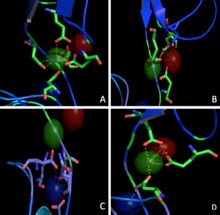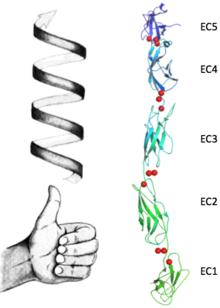Sandbox Reserved 1086
From Proteopedia
| Line 9: | Line 9: | ||
This family of proteins form huge membrane complexes called Desmosomes <ref>PMID: 20066089</ref>, of which the exact architecture is still unclear as well as the molecular mechanism(s) through which the adhesion takes place. | This family of proteins form huge membrane complexes called Desmosomes <ref>PMID: 20066089</ref>, of which the exact architecture is still unclear as well as the molecular mechanism(s) through which the adhesion takes place. | ||
| - | As the most of transmembrane proteins, cadherins´ extracellular and intracellular domains (N terminus and C terminus, respectively) have different structural and functional features. The <scene name='69/699999/Monomer/1'> outside portion</scene> (53,5 kDa) protrudes towards the extracellular matrix and is directly responsible for the adhesion process. The cell-cell adhesion (also called ''trans'' interaction), which is thought to occur upon the binding of <scene name='69/699999/Calcium/1'>calcium</scene>, takes place between cadherins belonging to opposite cells via <scene name='69/699999/Portions/1'>interaction</scene> of these portions. Interaction between neighbouring molecules ( | + | As the most of transmembrane proteins, cadherins´ extracellular and intracellular domains (N terminus and C terminus, respectively) have different structural and functional features. The <scene name='69/699999/Monomer/1'> outside portion</scene> (53,5 kDa) protrudes towards the extracellular matrix and is directly responsible for the adhesion process. The cell-cell adhesion (also called ''trans'' interaction), which is thought to occur upon the binding of <scene name='69/699999/Calcium/1'>calcium</scene>, takes place between cadherins belonging to opposite cells via <scene name='69/699999/Portions/1'>interaction</scene> of these portions. Interaction between neighbouring molecules (also called ''cis'' interaction) happens as well as it tightens the desmosomal plaque and prevents its disassembly. The inner domain has a more globular fold and connects the protein to the cytoskeleton forming an high electron density region called ''inner plaque''. The C-cadherin's structure here presented, suggests a molecular mechanism for adhesion between cells by classical cadherins such as [[1q5b]],[[1q5c]], and [[1q55]]. It provides a new framework for understanding both cis and trans cadherin interactions. |
</StructureSection> | </StructureSection> | ||
Revision as of 07:10, 23 April 2015
| This Sandbox is Reserved from 15/04/2015, through 15/06/2015 for use in the course "Protein structure, function and folding" taught by Taru Meri at the University of Helsinki. This reservation includes Sandbox Reserved 1081 through Sandbox Reserved 1090. |
To get started:
More help: Help:Editing |
Contents |
C-cadherin
| |||||||||||
Exploring the Structure
The extracellular moiety of the protein consists of five ectodomains () alternated by four . Each EC shares the same greek key fold, characteristic of immunoglobulin (Fig.1). Each interface between the EC is a calcium binding site coordinating three ions through the highly conserved motifs Asp-X-Asp, Leu-Asp-Arg-Glu and Asp-X-Asn-Asp-Asn. The binding of calcium is thought to confer rigidity as well as the classical curved shape to the structure and this is why it´s suggested to be a triggering if not even compulsory step to the adhesion process.
Calcium Coordination
Three calcium ions are differently coordinated in each interface between two neighbouring EC. Just one of these seems to be coordinated with the classical epta-coordination characteristic of the elements belonging to the first and second group (Fig.2A) while the others are bound without any particular geometry (Fig.2B,2C). Nevertheless, the presence of common coordinating residues (Glu) links these ions one to another forming a net of strong interactions (Fig.2D).
Molecular Geometry
Upon the calcium binding each EC contracts to the neighbour assuming a defined position which leads to the bended structure of the protein. These conformations changes in a sequel of ions form the unique final conformation of this protein. In Fig.3 the bending between EC1 and EC2 is shown in just one dimension, making clear the angle between the two main axes (approximately 22.5°). Fig.4, represents the bending between EC2 and EC3 while concealing this property between first and second EC. Because of this concealing due to the change in the observed direction, the change of position of EC3 respect EC2 can be no longer addressed to the same direction of the bending between EC1 and EC2 but to a different one. The occurrence of bendings in (at least) two different directions confers a torsional behaviour which goes through all the EC. These particular fashion contributes to the complexity of the protein´s ternary structure, shaping it into a bended left handed helix (Fig.5).
Adhesion Models
This conformation (called S) might play a key role in tackling the pulling forces within the desmosomal plaque. In fact, two cadherins that take contact from two different surfaces are going to perpetuate the left handed shape to the quaternary structure. As consequence the dimer unit connecting the two cells will resist to the stretching force with the same features of a spring (Fig.5). The S shape conformation shown in this model is not the only one observed. Experiments of electron microscopy [4] have identified different molecular species corresponding to the cadherin dimer. One of these is called W (1q55) shape in which cadherins partecipate to the binding by burying the 2 into the hydrophobic pocket (HAV sequence) present on the EC1 of the facing molecule [5]. Depending on the shape adopted by the dimer, these Trp have been seen promote the cis interaction as well. In the S shape in fact, although one 2 would remain in its partner´s hydrophobic pocket, the other one would be pulled out of the pocket and become free for interaction with additional neighbouring cadherins. This trimeric conformation is known as Y shape (1q5b).
Glycosylation
C cadherin is a N/O-glycosilated protein. It counts 15 sugars (, ) attached all over the structure to Thr-Asn residues but mainly to EC3 and EC4. Their role in the adhesion process in unknown and not suspected. Being transmembrane proteins, the presence of these sugars might be involved in the immune self-recognition.
Structural highlights
| 1q5a is a 2 chain structure with sequence from Mus musculus. The March 2008 RCSB PDB Molecule of the Month feature on Cadherin by David S. Goodsell is 10.2210/rcsb_pdb/mom_2008_3. Full crystallographic information is available from OCA.
This is a view if the molecule by groups, and the of the protein.
For a guided tour on the structure components use FirstGlance. | |
| Ligands: | , , |
| Related: | 1l3w, 1q55, 1q5b, 1q5c |
| Resources: | FirstGlance, OCA, RCSB, PDBsum |
References
- ↑ Basu R, Taylor MR, Williams ME. The classic cadherins in synaptic specificity. Cell Adh Migr. 2015 Apr 2:1-9. PMID:25837840 doi:http://dx.doi.org/10.1080/19336918.2014.1000072
- ↑ Fulga V, Rudico L, Balica AR, Cimpean AM, Saptefrati L, Margan MM, Raica M. Differential expression of e-cadherin in primary breast cancer and corresponding lymph node metastases. Anticancer Res. 2015 Feb;35(2):759-65. PMID:25667455
- ↑ Delva E, Tucker DK, Kowalczyk AP. The desmosome. Cold Spring Harb Perspect Biol. 2009 Aug;1(2):a002543. doi:, 10.1101/cshperspect.a002543. PMID:20066089 doi:http://dx.doi.org/10.1101/cshperspect.a002543
- ↑ He W, Cowin P, Stokes DL. Untangling desmosomal knots with electron tomography. Science. 2003 Oct 3;302(5642):109-13. PMID:14526082 doi:10.1126/science.1086957
- ↑ Boggon TJ, Murray J, Chappuis-Flament S, Wong E, Gumbiner BM, Shapiro L. C-cadherin ectodomain structure and implications for cell adhesion mechanisms. Science. 2002 May 17;296(5571):1308-13. Epub 2002 Apr 18. PMID:11964443 doi:http://dx.doi.org/10.1126/science.1071559





